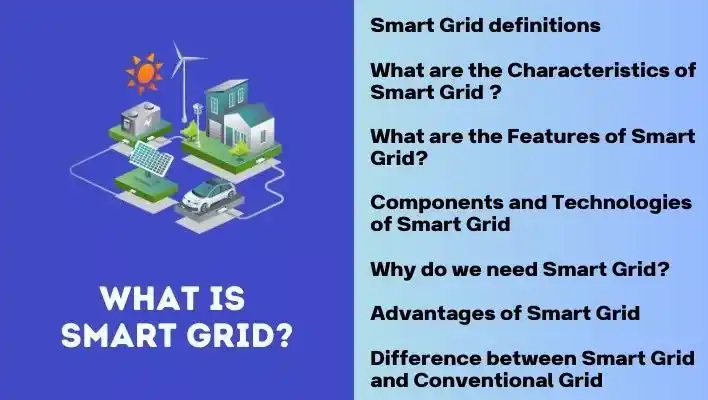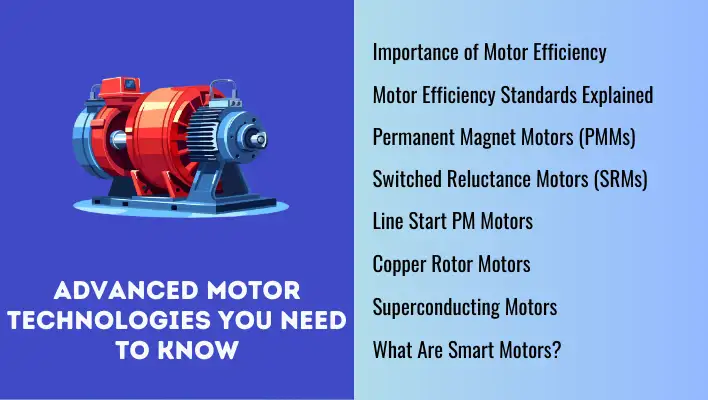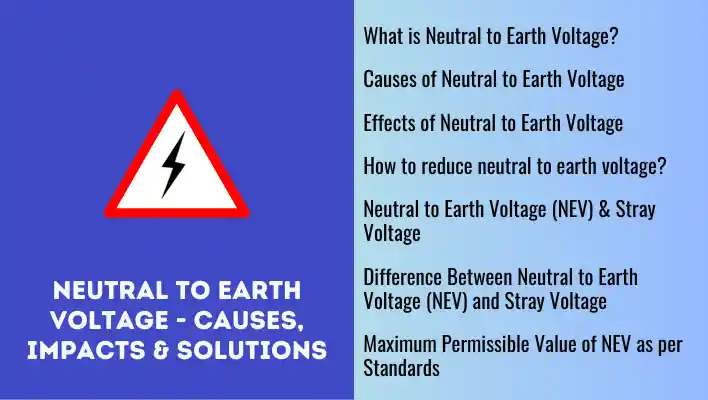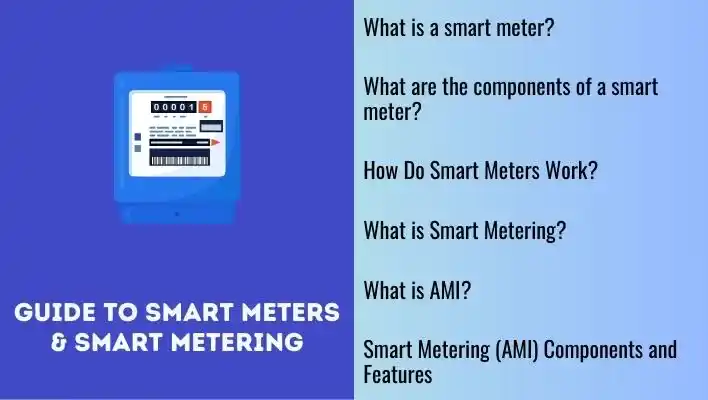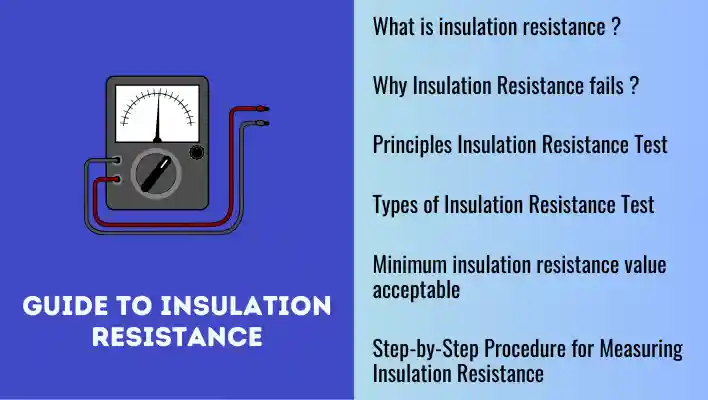In our increasingly connected world, the way we generate, distribute, and consume electricity is evolving rapidly. The advent of the Smart Grid is revolutionizing the electrical landscape, promising a more efficient, sustainable, and resilient energy system.
In this article, we will delve into the world of Smart Grid technology, exploring its definition, features, characteristics, advantages, and components. Join us on this journey as we uncover the potential of Smart Grids and their impact on our daily lives for a greener and more reliable energy future.
What is a Smart Grid?
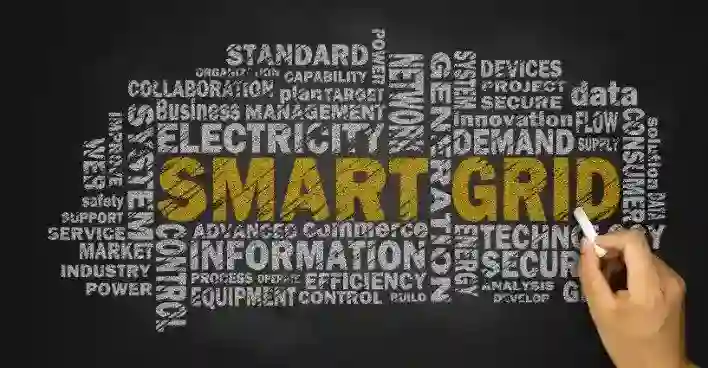
The term “Smart Grid” is less technical and more about marketing and promoting the idea of an intelligent power system network. As a result, there aren’t widely accepted textbook definitions. However, there are international energy platforms and regulatory bodies that generally follow a concept.
Definition as per European Technology Platform
A Smart Grid is an electricity network that can intelligently integrate the actions of all users connected to it – generators, consumers and those that do both – in order to efficiently deliver sustainable, economic and secure electricity supplies.
Definition as per International Energy Agency (IEA)
Smart grids are electricity networks that use digital technologies, sensors and software to better match the supply and demand of electricity in real time while minimizing costs and maintaining the stability and reliability of the grid.
It further states that a smart grid is an electricity network that uses digital and other advanced technologies to monitor and manage the transport of electricity from all generation sources to meet the varying electricity demands of end-users. Smart grids coordinate the needs and capabilities of all generators, grid operators, end-users, and electricity market stakeholders to operate all parts of the system as efficiently as possible, minimizing costs and environmental impacts while maximizing system reliability, resilience, and stability.
Definition as per US Department of Energy (DOE)
DOE endorses the definition mentioned by Smartgrid.gov which is,
The digital technology that allows for two-way communication between the utility and its customers, and the sensing along the transmission lines is what makes the grid smart. Like the Internet, the Smart Grid will consist of controls, computers, automation, and new technologies and equipment working together, but in this case, these technologies will work with the electrical grid to respond digitally to our quickly changing electric demand.
Definition as per International Electrotechnical Commission (IEC)
There is no well-defined and commonly accepted scope of what “smart” is and what it is not. It is generally understood that the smart grid encompasses the modernization of the electric grid. This comprises everything related to the electric system between any point of generation and any point of consumption. Smart grid technologies allow the grid to become more flexible, interactive and enable it to provide real-time feedback. It incorporates technologies and services that facilitate intelligent monitoring, control, communication and self-healing technologies.
Definition as per India’s National Smart Grid Mission
Smart Grid is an Electrical Grid with Automation, Communication and IT systems that can monitor power flows from points of generation to points of consumption (even down to appliances level) and control the power flow or curtail the load to match generation in real time or near real time. Smart Grids can be achieved by implementing efficient transmission & distribution systems, system operations, consumer integration and renewable integration. Smart grid solutions helps to monitor, measure and control power flows in real time that can contribute to identification of losses and thereby appropriate technical and managerial actions can be taken to arrest the losses.
Although the definitions do share similarities,it is evident that they all share similar objectives. Which are,
- A Smart Grid is an intelligent electricity network that integrates the actions of all connected users.
- It utilizes digital technologies, sensors, and software to match supply and demand of electricity in real time.
- The primary goals are to minimize costs, enhance grid stability and reliability.
- Smart Grids encompass modernizing the entire electric system, from generation to consumption.
- They offer flexibility, interactivity, and real-time feedback.
- Smart Grids employ technologies for intelligent monitoring, control, communication, and self-healing.
- These grids monitor and control power flows in real time and adapt to changing electricity demand.
- The focus is on identifying and addressing losses promptly.
- The Smart Grid represents a dynamic and responsive approach to electricity distribution.
In summary, these definitions collectively prove that a Smart Grid is an intelligent, digitally-driven electrical system that integrates various components, technologies, and stakeholders to improve efficiency, reliability, and sustainability in electricity generation, distribution, and consumption.
Also Read: Power Supply System | A Comprehensive Guide
What are the essential Characteristics of Smart Grid ?

All the above definitions make the smart grid a variable notion and it will keep on updating with the development of new unknown technologies.
Hence the smart grid definition should not be linked with its technical advances but rather it must cover applications, uses and benefits in combination with booming industries and tech-savvy civilization. In that respect it requires many essential characteristics, including, but not limited to:
- Information Exchange: It should seamlessly facilitate the exchange of information among multiple systems and components, ensuring the power grid’s efficient operation at all times.
- Integration of Resources: The smart grid must readily incorporate diverse utility-side resources, including the rapidly expanding array of irregular renewable resources from consumers.
- Consumer Engagement: It should empower consumers with access to energy information, control over power and participation in electricity markets.
- Intelligent Transformation: The smart grid must evolve the existing, outdated grid into an intelligent entity through software and hardware integration, allowing electricity to flow seamlessly from multiple sources connected to the grid.
- Storage Integration: The grid should permit energy storage devices, such as batteries, to feed stored energy back into the grid.
- Consumer-Side Power Generation: It should support and enable power generation at consumer premises.
- Environmental Responsibility: The smart grid should ensure that electricity production and distribution have minimal negative impact on the environment.
- Resilience: In the face of natural disasters or cyber-attacks, it must possess adaptive self-defensive mechanisms to mitigate or eliminate adverse conditions, ensuring continuous power supply.
- Maintenance Efficiency: Regular, unmanned maintenance is facilitated through active surveillance and checks of all critical grid components.
- Reliable Distribution: It must provide consistent electricity transmission and distribution, guaranteeing improved power supply for all stakeholders.
This comprehensive vision of the smart grid is essential in shaping its future to meet the needs of our ever-advancing technological landscape.
Also Read: Understanding Conventional Power Plants – A Detailed Exploration
What are the Features of Smart Grid?
Smart grids have several features that directly benefit consumers by improving their experience with energy consumption and management. Here’s an explanation of these characteristics and their advantages for consumers:
- Real-Time Monitoring: Smart grids provide consumers with the ability to monitor their energy usage in real-time. This allows them to gain a clear understanding of how and when they use electricity, which can lead to more informed decisions about energy conservation and cost savings.
- Automated Outage Management and Faster Restoration: Smart grids have the capability to automatically detect outages and faults in the grid. This means faster identification of issues and quicker restoration of power, reducing inconvenience and downtime for consumers.
- Dynamic Pricing Mechanisms: Smart grids introduce dynamic pricing, where electricity rates vary based on the time of day or grid conditions. This offers consumers the opportunity to save money by using electricity during off-peak hours and reducing consumption during peak demand periods.
- Incentivize Consumers to Alter Usage: Dynamic pricing and demand response programs incentivize consumers to adjust their energy usage in response to pricing signals. This can lead to lower electricity bills and helps balance supply and demand on the grid, benefiting the overall reliability of the grid.
- Better Energy Management: With real-time data and insights into energy consumption, consumers can manage their energy use more efficiently. They can identify energy-hungry appliances or habits and make adjustments to save on energy costs.
- In-House Displays: Smart grid technology often includes in-house displays that provide consumers with real-time information about their electricity usage. This can help consumers make immediate changes to reduce consumption during peak pricing periods.
- Web Portals and Mobile Apps: Many smart grid systems offer web portals and mobile applications that allow consumers to access detailed information about their energy usage from anywhere. These tools provide convenience and accessibility for monitoring and managing energy consumption.
- Track and Manage Energy Usage: Consumers can track and manage their energy usage through these platforms, setting energy-saving goals and receiving recommendations for optimizing energy consumption.
- Opportunities to Reduce and Conserve Electricity: Smart grids offer consumers various opportunities to reduce and conserve electricity, whether through energy-efficient appliances, time-of-use pricing, or participation in demand response programs. This not only helps reduce energy bills but also contributes to environmental sustainability.
- Environmental Awareness: With greater visibility into energy consumption and its environmental impact, consumers are more likely to adopt energy-efficient practices and reduce their carbon footprint, contributing to a more sustainable future.
In summary, the features of smart grids directly benefit consumers by providing them with real-time information, cost-saving opportunities, better energy management tools, and the ability to actively participate in grid operations. This leads to increased control over energy usage, lower costs, and a more sustainable approach to electricity consumption.
Also Read: What is interconnected power system or grid?
Components and Technologies of Smart Grid
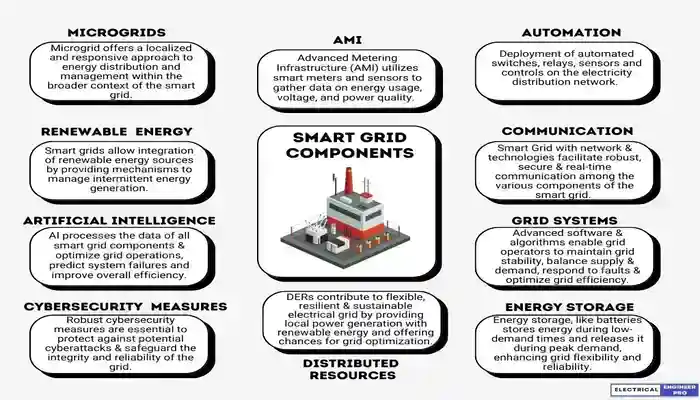
A smart grid is an advanced electrical grid system that incorporates various technologies and components to enhance the efficiency, reliability, and sustainability of electricity generation, distribution, and consumption. The key components of a smart grid include:
- Advanced Metering Infrastructure (AMI): Smart meters and sensors are installed throughout the grid to collect real-time data on energy consumption, voltage levels, and power quality. This data is used to optimize energy distribution and enable demand response programs., ultimately contributing to a more efficient and responsive smart grid.
- Distribution Automation: It is a key component of a smart grid that involves the deployment of automated switches, relays, sensors and controls on the electricity distribution network. This technology is used to detect and respond to faults and other issues in the grid, with the overall goal of reducing downtime and improving grid reliability.
- Communication Infrastructure: It is a vital element within a smart grid that comprises the network and technologies used to facilitate robust, secure and real-time communication among the various components of the smart grid. This infrastructure connects utilities, consumers, and grid devices, allowing for the exchange of data and information.
- Grid Management and Control Systems: It involves advanced software systems and algorithms to monitor and control the electrical grid.This enable grid operators to maintain grid stability, balance supply and demand, respond to faults, and optimize grid efficiency, contributing to a more reliable and efficient smart grid.
- Energy Storage: Grid-scale energy storage systems, such as batteries and pumped hydro, are used to store excess energy during periods of low demand and release it during peak demand, improving grid flexibility and reliability.
- Distributed Energy Resources (DERs): Distributed Energy Resources (DERs) are a collection of decentralized energy generation and storage technologies that are often smaller in scale and located close to the point of consumption. They contribute to a more flexible, resilient and sustainable electrical grid by providing local power generation, reducing transmission losses, integrating renewable energy and offering opportunities for demand response and grid optimization.
- Cybersecurity Measures: Given the increased connectivity in a smart grid, robust cybersecurity measures are essential to protect against potential cyberattacks and safeguard the integrity and reliability of the grid.
- Data Analytics and Artificial Intelligence (AI): Data analytics and AI are used to process the vast amount of data generated by smart grid components. They help optimize grid operations, predict system failures, and improve overall efficiency.
- Advanced Sensors and Monitoring Devices: Various sensors and monitoring devices are deployed throughout the grid to collect data on voltage, current, temperature, and other parameters, allowing for better grid management.
- Renewable Energy: Smart grids facilitate the integration of renewable energy sources into the grid by providing mechanisms to manage intermittent energy generation and balance it with conventional power sources
- Microgrids: As part of the smart grid ecosystem, microgrids play a vital role in modernizing and improving the overall performance and resilience of the electrical grid. It offers a localized and responsive approach to energy distribution and management within the broader context of the smart grid. They provide benefits such as reduced transmission losses, enhanced energy efficiency, grid independence, responsiveness to grid conditions, sustainability and scalability.
These components work together to create a more efficient, reliable, and sustainable electrical grid that can adapt to changing energy needs and technologies while reducing environmental impact and energy costs.
Why do we need Smart Grid?
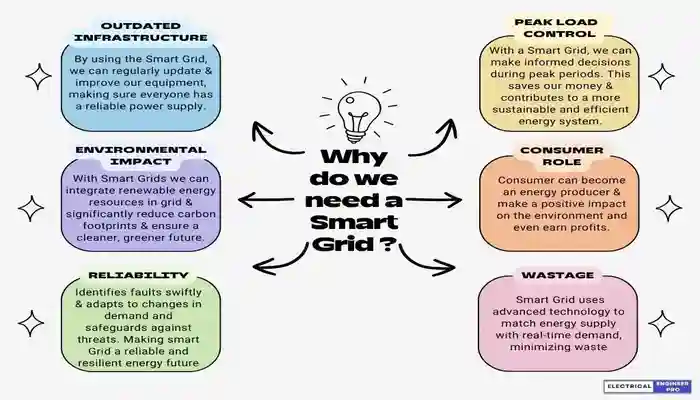
- Outdated Infrastructure: Imagine a world where our power infrastructure is seamlessly updated, ensuring that it never falters or causes frustrating blackouts. By embracing the Smart Grid, we have the opportunity to replace and modernize outdated equipment during routine maintenance, guaranteeing a reliable power supply for all.
- Peak Load (Demand) Management: In a traditional grid you all have to pay for the energy (KWH) you consume as well as the peak load (KW Demand) charges. This skyrockets your electricity bills. With a Smart Grid, you can take charge of your energy consumption, making informed decisions during peak periods. This not only saves you money but also contributes to a more sustainable and efficient energy system.
- Environmental Impact: We’re in a race against climate change, and Smart Grid technology is our ally. By integrating renewable energy sources like solar, wind and biomass into the grid, we can significantly reduce carbon footprints and ensure a cleaner, greener future.
- Consumer Role: The Smart Grid empowers you to be more than just an energy consumer. You can become an energy producer, making a positive impact on the environment and even earning profits. It’s your chance to play an active role in shaping the energy landscape.
- Reliability: Picture a world where power outages are rare and swiftly resolved. The Smart Grid’s ability to detect faults, respond to fluctuations in demand, and secure against threats means uninterrupted power supply, even during challenging times.
- Wastage: No more wasted electricity or load shedding due to over-estimations. The Smart Grid uses advanced technology to match energy supply with real-time demand, minimizing waste and ensuring that every unit of electricity generated is put to good use.
By embracing the Smart Grid, we’re not just improving our energy infrastructure; we’re shaping a brighter, more efficient, and sustainable future for us all. Join the movement towards a smarter, cleaner, and more reliable energy grid.
Advantages of Smart Grid
Smart Grid implementations provide a wide array of benefits to different segments of society, including utility companies, customers, and regulators. These benefits contribute to a more efficient, resilient, and sustainable electrical grid. Here’s an explanation of the mentioned benefits:
- Reduction of T&D Losses: T&D (Transmission and Distribution) losses refer to the energy lost as electricity travels from power plants to end-users. Smart Grid technologies help minimize these losses, resulting in cost savings for utility companies and more efficient energy distribution.
- Peak Load Management, Improved QoS, and Reliability: Smart Grids enable better management of peak electricity demand. This leads to improved grid reliability and a higher quality of service (QoS), which means fewer outages and a more consistent power supply for consumers.
- Reduction in Power Purchase Cost: Smart Grids facilitate more efficient power generation and distribution, ultimately reducing the cost of purchasing electricity. This can lead to cost savings for both utility companies and consumers.
- Better Asset Management: Smart Grid technology allows utility companies to monitor and manage grid assets more effectively. This results in extended asset lifespans and reduced maintenance costs.
- Increased Grid Visibility and Self-Healing Grids: Smart Grids provide real-time data and monitoring, enhancing the visibility of grid operations. They also enable self-healing capabilities, meaning the grid can automatically respond to faults and disruptions, minimizing downtime.
- Renewable Integration and Accessibility to Electricity: Smart Grids support the integration of renewable energy sources, such as solar and wind power. This promotes sustainability and increases access to clean energy.
- Increased Options such as ToU Tariff, DR Programs, Net Metering: Smart Grids offer consumers a range of options, including Time-of-Use (ToU) tariffs, demand response (DR) programs, and net metering. ToU tariffs provide pricing flexibility, DR programs encourage consumers to reduce energy use during peak times, and net metering allows customers to sell excess electricity back to the grid.
- Satisfied Customers and Financially Sound Utilities: The improvements in grid reliability and efficiency result in more satisfied customers. Additionally, utilities can operate more efficiently, reducing operational costs and ensuring their financial stability.
In summary, Smart Grid implementations benefit various stakeholders by reducing losses, improving grid management, lowering costs, increasing sustainability, and enhancing options for both utilities and consumers. The result is a more reliable, responsive, and cost-effective electrical grid that promotes customer satisfaction and supports the goals of a sustainable energy future.
Difference between Smart Grid and Conventional Grid
| Smart Grid | Conventional Grid | |
| Grid Resilience and Security | Smart Grids employ advanced cybersecurity measures to safeguard against cyber threats. The two-way communication in Smart Grids is fortified with robust security protocols, ensuring the integrity and confidentiality of data. | Typically has fewer built-in security features. The older infrastructure are susceptible to cyber threats due to limited security measures. |
| Communication & IT Integration | Smart Grids utilize advanced communication and information technologies for real-time monitoring, control, and automation. They employ sensors, smart meters, and other devices to collect data, optimizing grid operations. | Relies on traditional, manual methods of grid monitoring and control. Communication is limited, and information flow is not as dynamic or instantaneous as in a Smart Grid. |
| Load Management | Implements advanced load management techniques, allowing for better demand response capabilities. Through real-time communication and control, Smart Grids can adjust energy consumption patterns to match supply and demand, optimizing the use of resources. | Relies on traditional load management strategies with limited ability to respond dynamically to changes in demand. |
| Decentralized Decision-Making | Promotes decentralized decision-making through the use of intelligent devices and sensors. This allows for more autonomous operation and quicker response to local conditions. | Primarily relies on centralized control and decision-making, with limited autonomy at the local level. |
| Automation and Control | Utilizes automation extensively to enhance grid performance. This includes automated fault detection, isolation, and restoration (self-healing), as well as demand response mechanisms that adjust power consumption based on real-time conditions. | Lacks sophisticated automation features. Operators often need to manually identify and address faults, and there is limited ability to adapt to changing conditions in real time. |
| Integration of Renewable Energy | Designed to efficiently integrate and manage distributed energy resources, including renewable energy sources. Smart Grids facilitate the seamless integration of solar panels, wind turbines, and other distributed generation technologies. | Originally designed to handle centralized power generation from a limited number of sources. Integrating renewable sources into a conventional grid can be challenging without extensive modifications. |
| Predictive Maintenance | Utilizes predictive maintenance algorithms and condition monitoring to anticipate and address potential equipment failures before they occur. This approach improves overall grid reliability and reduces downtime. | Generally relies on reactive maintenance practices, addressing issues after they are detected or reported. |
| Voltage Control | Implements advanced voltage control mechanisms to maintain optimal voltage levels across the grid. This is particularly important with the increasing integration of renewable energy sources. | Voltage control is typically less sophisticated and may rely on manual adjustments. |
| Billing & Metering | Integrates advanced metering infrastructure (AMI) for accurate and real-time billing. Smart meters provide detailed consumption information and enable more flexible billing options. | Relies on traditional metering systems with less granularity in consumption data and billing options. |
| Resilience to Natural Disasters | Incorporates features for enhanced resilience to natural disasters. The self-healing capabilities of Smart Grids can isolate damaged sections and restore power more quickly. | Typically has longer recovery times after natural disasters, as fault detection and restoration processes may require more manual intervention. |
FAQs
How does a smart grid work?
Smart grid works as a combination of advanced technologies, communication networks, and automated systems to create a more responsive and intelligent electrical grid. It aims to improve efficiency, reduce energy losses, integrate renewable energy sources, and enhance the overall reliability of the electricity supply.
How does a Smart Grid benefit me as a consumer?
Smart Grid provides consumers with greater control over their energy usage, promotes efficiency, and aligns with environmentally conscious practices, ultimately enhancing the overall consumer experience in the realm of electricity consumption.
What role do smart meters play in a Smart Grid?
Smart meters serve as a foundational component of a Smart Grid, enabling real-time communication, data-driven decision-making, and empowering consumers to actively participate in energy management programs.
Are Smart Grids being implemented globally?
Yes, Smart Grids are being implemented globally. Countries across North America, Europe, Asia-Pacific, the Middle East, Africa, and Latin America are adopting Smart Grid technologies to modernize their electrical infrastructure and achieve various energy-related goals.
How does a Smart Grid support renewable energy integration?
A Smart Grid supports renewable energy integration by enabling real-time monitoring, demand response, and optimized grid management. It accommodates the variability of renewable sources, integrates energy storage, and encourages sustainable consumption through dynamic pricing and decentralized energy generation.

